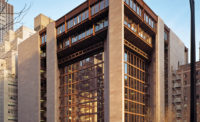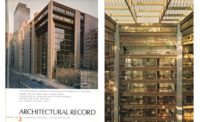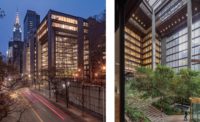When a renovation was proposed for the magnificent modernist Ford Foundation in New York, the project was met by cries of concern from die-hard preservationists, whose idea of do-no-harm often seems to be do-not-touch. The landmarked granite and Cor-Ten tower, designed by Kevin Roche and John Dinkeloo and opened in 1968, was one of the first such buildings to create an indoor urban garden—designed by Dan Kiley—in the midst of its soaring 13-story glass-roofed atrium, with offices surrounding it on three sides. From those elegant perches, furnished with custom pieces by Warren Platner, the Foundation’s program officers dispensed millions in annual grants for everything from the arts to AIDS research, from international development to civil rights legal funds. But it turned out the structure needed help, too: it was filled with asbestos, there was no sprinkler system, and it wasn’t ADA compliant. And, while the building is “a masterpiece,” says the Foundation’s president Darren Walker, aspects of the design sent the wrong message for the 21st century. “It was elitist and hierarchal then,” he notes. “Today, philanthropy has to be transparent and open.” [Watch a video interview with Darren Walker.]

Now after a two-year, $205-million facelift, sensitively undertaken by Gensler, we can say to those who feared this architectural icon would be ruined: you can relax.
Start with the overgrown garden, which has been de-jungled by Miami-based landscape architect Raymond Jungles, and its circulation tweaked so it can be circumnavigated in a wheel chair. Then into the lobby—with its polished brick floors that seem to flow into the brick paving of the entry exterior—where a space on one side has been re-purposed into a new common area and café for staff and their guests. Elsewhere the architects have carved out room for a lofty gallery—the ceiling is 24 feet high—to host public exhibitions that touch on Ford’s mission.
Half of the original Platner furniture has been lovingly restored, as have many of the architectural details, such as the elegant Cor-Ten and leather balustrades that line the glass walls of the atrium on each floor. Even in the auditorium, whose custom seating famously had ashtrays that swung out from the arms, the designers kept some “cigar” ashtrays as mementos of a bygone—if less health-conscious—era.
But the most radical change turns out to be in many ways an improvement. The building was formerly 85 percent private offices and now is almost all open plan. That means that the sheetrock that separated those offices is mostly gone, and you can see through the building more easily, across the glass atrium and outside, from many vantage points. The president’s magisterial executive suite on the top floor was big enough to make three generous conference rooms out of it, and Walker now sits in a smaller, if still spacious, office a few floors down. Gensler has designed the open plan workstations and lighting fixtures in a minimalist style of dark wood and polished brass that fits the prevailing esthetic.
The new openness reflects the sharpening of the Foundation’s focus on equity and equality and the deepening of its engagement in those issues, with more space to convene meetings and interact with its broad constituency. The building is now called The Ford Foundation Center for Social Justice, and a new motto—“We believe in the inherent dignity of all people”—floats above the reception desk. The original, dignified ambience is still there, all buffed and polished, but the prevalent palette of what the designers quietly call “Ford brown”—as well as the once-clubby atmosphere—is now lightened by the new garden, greater transparency and the vivid display throughout of impressive contemporary art from the Foundation’s collection of more than 400 works. Most are by women and artists of color and many are from places where the Foundation has had a particular impact. A colorful commissioned mural by the Nigerian American Odili Donald Odita enhances one space while a painting by Kehinde Wiley, who did President Obama’s official portrait, greets visitors in the lobby.
“Kevin [Roche] always talked about a tranquil environment,” recalls Walker. “But today it is not about tranquility but energy and urgency and bringing people together to solve problems.”






Post a comment to this article
Report Abusive Comment